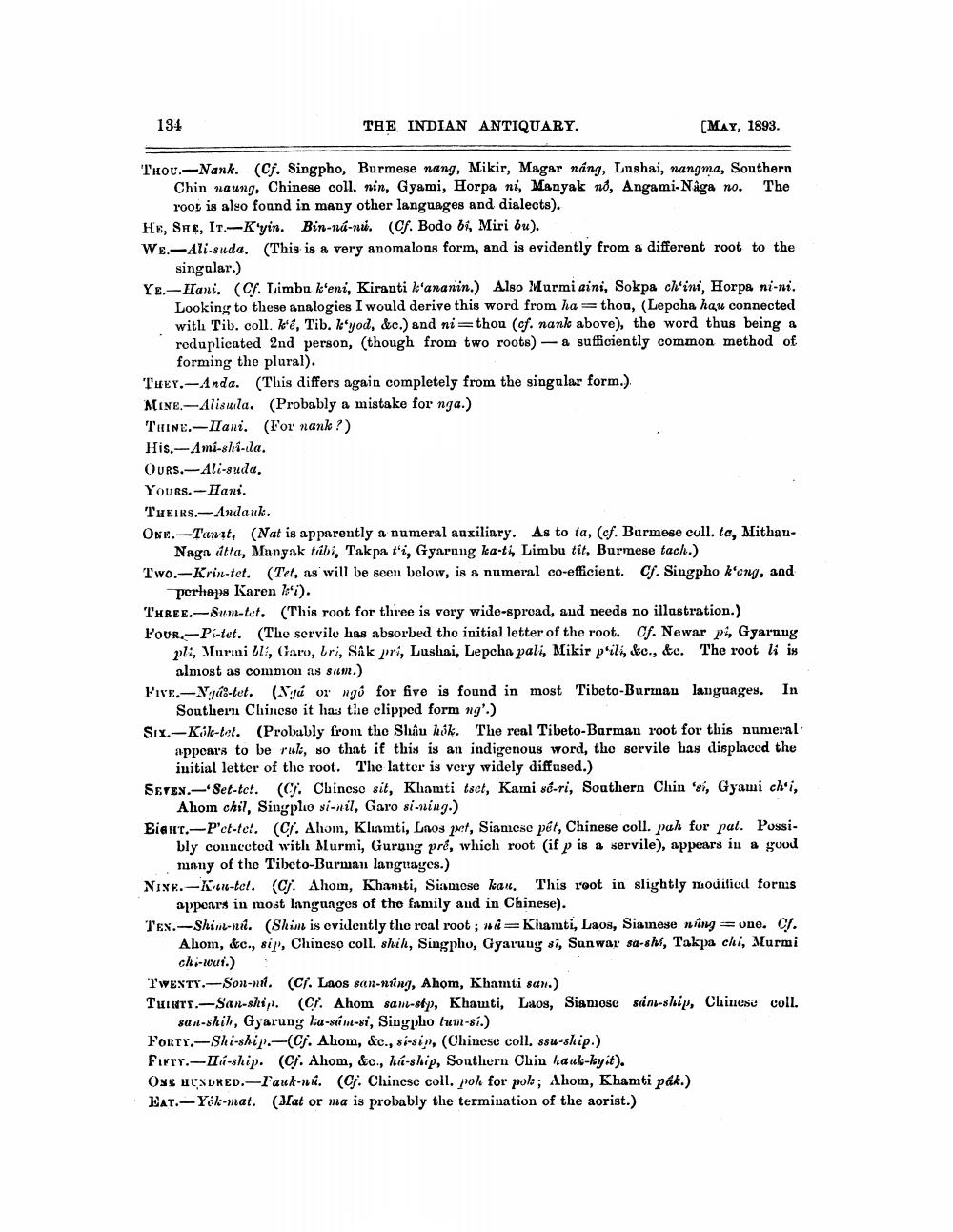________________
134
THE INDIAN ANTIQUARY.
[MAY, 1893.
THOU.-Nank. (Cf. Singpho, Burmese nang, Mikir, Magar náng, Lushai, nangma, Southern
Chin naung, Chinese coll. min, Gyami, Horpa ni, Manyak no, Angami-Naga no. The
root is also found in many other languages and dialects). HE, SHE, IT.--K'yin. Bin-ná-nué. (Cf. Bodo bi, Miri bu). WE.-Ali-suda. (This is a very anomalous form, and is evidently from a different root to the
singalar.) YE.- Elani. (Cf. Limba k'eni, Kiranti k'ananin.) Also Murmi aini, Sokpa ch'ini, Horpa ni-ni.
Looking to these analogies I would derive this word from ha=thou, (Lepcha hau connected with. Tib. coll. k., Tib. 'yod, &c.) and ni=thou (cf. nank above), the word thus being a reduplicated 2nd person, (though from two roots) - a sufficiently common method of
forming the plural). Tuey.-Anda. (This differs again completely from the singular form.). Mine.- Alisula. (Probably a mistake for nga.) Tune.-Hani. (For nank?) His.-Ami-shi-la. OURS.-Ali-suda, YOURS.-Hani. THEIRS.-Andauk. ONE.-Tant, (Nat is apparently a numeral auxiliary. As to ta, (cf. Burmese coll. ta, Mithau
Naga itta, Manyak tibi, Takpa t'i, Gyarung ka-ti, Limbu tit, Burmese tach.) Two-Krin-tet. (Tet, as will be seen below, is a numeral co-efficient. c. Singpho k‘ong, and
perhaps Karen 17). THREE.-Sum-tet. (This root for three is very wide-spread, and needs no illustration.) Four.-Pi-tet. (Tho servilo has absorbed the initial letter of the root. Of. Newar pi, Gyarang
pli, Murmi Oli, Caro, Uri, Sak pri, Lushai, Lepchn pali, Mikir poils, &o., &o. The root is
almost as common as sum.) Five.Náz-let. (Xá 01 Ngo for five is found in most Tibeto-Burman languages. In
Southern Chineso it has the clipped form ng'.) Six.-Kik-lat. (Probably from the Shiu hsk. The real Tibeto-Barman root for this numeral
appears to be ruls, so that if this is an indigenous word, the servile has displaced the
initial letter of the root. The latter is very widely diffused.) SETEX.-Set-tet. C. Chinese sit, Khamti tsct, Kami se-ri, Southern Chin 'si, Gyami choi,
Ahom chil, Singplio si-nil, Garo si-ning.) Eient.-P'et-tel. (Cf. Ahom, Klamti, Laos pet, Siamese pét, Chinese coll. pah for pat. Possi
bly connected with Murmi, Gurung pré, which root (if p is a servile), appears in a good
mony of the Tibeto-Burman languages.) NINE.-Kantel. (cf. Ahom, Khamti, Siamose kal. This root in slightly modified forms
appears in most langanges of the family and in Chinese). Tex.-Shirik-nat. (Shim is evidently the real root; ni=Khamti, Laos, Siainese ning =vne. C.
Ahom, &c., si, Chineso coll. shih, Singpho, Gyarung si, Sunwar sa-shi, Takpa chi, Murmi
chi-wui.) TWENTY.-Sonnt. (Cl. Laos san-nting, Ahom, Khamti sun.) Turs.-San-ski. (ct. Ahom sami-skp, Khamti, Laos, Siamoso siin-ship, Chinese coll.
sart-shih, Gyarung ka-san-si, Singpho tum-si.) FORTY.-Shi-ship.-Cj. Ahom, &c., si-sin, (Chinese coll. ssu-ship.) Furry.-II-ship. (C/. Ahom, &c., há-ship, Southern Chin haul-key it). ONS UCSDRED.-Pauk-nt. (C. Chinese coll. pok for pol; Ahom, Khamti pák.) EAT.-Yök-mat. (Hat or ma is probably the termination of the aorist.)




